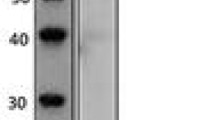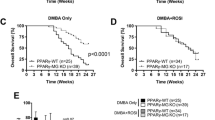Abstract
Fibrates belong to a group of ligands of peroxisome proliferator-activated receptor alpha (PPARα), which play a role in the regulation of CYP epoxygenases and soluble epoxide hydrolase (sEH), key enzymes in the metabolism of biologically highly active epoxyeicosatrienoic acids (EETs). We demonstrated that low doses of fibrates stimulate proliferation of the MCF7 cell line, while high doses suppress it. The increase in cell proliferation was accompanied by an increase in CYP epoxygenases and decrease in sEH levels. The overall level of PPARα remained same after low-dose fibrate stimulation; however, there was a significant shift of the receptor to the cell nucleus. PPARα expression was further demonstrated by immunohistochemistry in both carcinoma and healthy breast tissue samples both in the cytoplasm and in the nuclei. We have also observed higher nuclear PPARα positivity in tumor tissues. Although our results obtained for MCF7 cells suggest the potential role of PPARα in cell proliferation, we did not find an association between nuclear localization of PPARα and the expression of proliferation marker Ki-67 in tumor tissues. The exact role of PPARα in carcinogenesis still remains unclear.



Similar content being viewed by others
References
Mangelsdorf DJ, Thummel C, Beato M, Herrlich P, Schutz G, Umesono K, Blumberg B, Kastner P, Mark M, Chambon P, Evans RM (1995) The nuclear receptor superfamily: the second decade (in eng). Cell 83:835–839
Hsu MH, Palmer CN, Song W, Griffin KJ, Johnson EF (1998) A carboxyl-terminal extension of the zinc finger domain contributes to the specificity and polarity of peroxisome proliferator-activated receptor DNA binding (in eng). J Biol Chem 273:27988–27997. https://doi.org/10.1074/jbc.273.43.27988
Gervois P, Chopin-Delannoy S, Fadel A, Dubois G, Kosykh V, Fruchart JC, Najib J, Laudet V, Staels B (1999) Fibrates increase human REV-ERBalpha expression in liver via a novel peroxisome proliferator-activated receptor response element (in eng). Mol Endocrinol (Baltimore, Md) 13:400–409. https://doi.org/10.1210/mend.13.3.0248
Kliewer SA, Umesono K, Noonan DJ, Heyman RA, Evans RM (1992) Convergence of 9-cis retinoic acid and peroxisome proliferator signalling pathways through heterodimer formation of their receptors (in eng). Nature 358:771–774. https://doi.org/10.1038/358771a0
Peters JM, Shah YM, Gonzalez FJ (2012) The role of peroxisome proliferator-activated receptors in carcinogenesis and chemoprevention (in eng). Nat Rev Cancer 12:181–195. https://doi.org/10.1038/nrc3214
Schoonjans K, Staels B, Auwerx J (1996) Role of the peroxisome proliferator-activated receptor (PPAR) in mediating the effects of fibrates and fatty acids on gene expression (in eng). J Lipid Res 37:907–925
Shipman KE, Strange RC, Ramachandran S (2016) Use of fibrates in the metabolic syndrome: a review (in eng). World J Diabetes 7:74–88. https://doi.org/10.4239/wjd.v7.i5.74
Zambon A, Cusi K (2007) The role of fenofibrate in clinical practice (in eng). Diabetes Vasc Dis Res 4(Suppl 3):S15–S20. https://doi.org/10.3132/dvdr.2007.053
Milionis H (2014) Combining a statin with a fibrate versus fibrate monotherapy: efficacious but safe? (in eng). Exp Opin Drug Safety 13:267–269. https://doi.org/10.1517/14740338.2014.887679
Staels B, Dallongeville J, Auwerx J, Schoonjans K, Leitersdorf E, Fruchart JC (1998) Mechanism of action of fibrates on lipid and lipoprotein metabolism (in eng). Circulation 98:2088–2093
Goya K, Sumitani S, Xu X, Kitamura T, Yamamoto H, Kurebayashi S, Saito H, Kouhara H, Kasayama S, Kawase I (2004) Peroxisome proliferator-activated receptor alpha agonists increase nitric oxide synthase expression in vascular endothelial cells (in eng). Arterioscler Thromb Vasc Biol 24:658–663. https://doi.org/10.1161/01.atv.0000118682.58708.78
Yoon M (2009) The role of PPARalpha in lipid metabolism and obesity: focusing on the effects of estrogen on PPARalpha actions (in eng). Pharmacol Res 60:151–159. https://doi.org/10.1016/j.phrs.2009.02.004
Contreras AV, Torres N, Tovar AR (2013) PPAR-α as a key nutritional and environmental sensor for metabolic adaptation (in eng). Adv Nutr 4:439–452. https://doi.org/10.3945/an.113.003798
Koh EH, Kim MS, Park JY, Kim HS, Youn JY, Park HS, Youn JH, Lee KU (2003) Peroxisome proliferator-activated receptor (PPAR)-alpha activation prevents diabetes in OLETF rats: comparison with PPAR-gamma activation (in eng). Diabetes 52:2331–2337. https://doi.org/10.2337/diabetes.52.9.2331
Aasum E, Belke DD, Severson DL, Riemersma RA, Cooper M, Andreassen M, Larsen TS (2002) Cardiac function and metabolism in Type 2 diabetic mice after treatment with BM 17.0744, a novel PPAR-alpha activator (in eng). Am J Physiol Heart Circ Physiol 283:H949–H957. https://doi.org/10.1152/ajpheart.00226.2001
Park CW, Zhang Y, Zhang X, Wu J, Chen L, Cha DR, Su D, Hwang MT, Fan X, Davis L, Striker G, Zheng F, Breyer M, Guan Y (2006) PPARalpha agonist fenofibrate improves diabetic nephropathy in db/db mice (in eng). Kidney Int 69:1511–1517. https://doi.org/10.1038/sj.ki.5000209
Urbanska K, Pannizzo P, Grabacka M, Croul S, Del Valle L, Khalili K, Reiss K (2008) Activation of PPARalpha inhibits IGF-I-mediated growth and survival responses in medulloblastoma cell lines (in eng). Int J Cancer 123:1015–1024. https://doi.org/10.1002/ijc.23588
Panigrahy D, Kaipainen A, Huang S, Butterfield CE, Barnes CM, Fannon M, Laforme AM, Chaponis DM, Folkman J, Kieran MW (2008) PPARalpha agonist fenofibrate suppresses tumor growth through direct and indirect angiogenesis inhibition (in eng). Proc Natl Acad Sci USA 105:985–990. https://doi.org/10.1073/pnas.0711281105
Liang H, Kowalczyk P, Junco JJ, Klug-De Santiago HL, Malik G, Wei SJ, Slaga TJ (2014) Differential effects on lung cancer cell proliferation by agonists of glucocorticoid and PPARalpha receptors (in eng). Mol Carcinog 53:753–763. https://doi.org/10.1002/mc.22029
Grabacka M, Plonka PM, Urbanska K, Reiss K (2006) Peroxisome proliferator-activated receptor alpha activation decreases metastatic potential of melanoma cells in vitro via down-regulation of Akt (in eng). Clin Cancer Res 12:3028–3036. https://doi.org/10.1158/1078-0432.ccr-05-2556
Cizkova K, Steigerova J, Gursky J, Ehrmann J (2016) Stimulating effect of normal-dosing of fibrates on cell proliferation: word of warning (in eng). Lipids Health Dis 15:164. https://doi.org/10.1186/s12944-016-0335-z
Suchanek KM, May FJ, Robinson JA, Lee WJ, Holman NA, Monteith GR, Roberts-Thomson SJ (2002) Peroxisome proliferator-activated receptor alpha in the human breast cancer cell lines MCF-7 and MDA-MB-231 (in eng). Mol Carcinog 34:165–171. https://doi.org/10.1002/mc.10061
Jiang JG, Chen CL, Card JW, Yang S, Chen JX, Fu XN, Ning YG, Xiao X, Zeldin DC, Wang DW (2005) Cytochrome P450 2J2 promotes the neoplastic phenotype of carcinoma cells and is up-regulated in human tumors (in eng). Cancer Res 65:4707–4715. https://doi.org/10.1158/0008-5472.can-04-4173
Shen GF, Jiang JG, Fu XN, Wang DW (2008) Promotive effects of epoxyeicosatrienoic acids (EETs) on proliferation of tumor cells (in chi). Ai zheng = Aizheng = Chinese J Cancer 27:1130–1136
Cizkova K (2018) Expression of cytochrome P450 epoxygenases and soluble epoxide hydrolase is regulated by hypolipidemic drugs in dose-dependent manner (in eng). Toxicol Appl Pharmacol 355:156–163. https://doi.org/10.1016/j.taap.2018.06.025
Wei X, Zhang D, Dou X, Niu N, Huang W, Bai J, Zhang G (2014) Elevated 14,15- epoxyeicosatrienoic acid by increasing of cytochrome P450 2C8, 2C9 and 2J2 and decreasing of soluble epoxide hydrolase associated with aggressiveness of human breast cancer (in eng). BMC Cancer 14:841. https://doi.org/10.1186/1471-2407-14-841
Holliday DL, Speirs V (2011) Choosing the right cell line for breast cancer research (in eng). Breast Cancer Res BCR 13:215. https://doi.org/10.1186/bcr2889
Berglund L, Brunzell JD, Goldberg AC, Goldberg IJ, Sacks F, Murad MH, Stalenhoef AFH (2012) Evaluation and treatment of hypertriglyceridemia: an endocrine society clinical practice guideline. J Clin Endocrinol Metab 97:2969–2989. https://doi.org/10.1210/jc.2011-3213
Umemoto T, Fujiki Y (2012) Ligand-dependent nucleo-cytoplasmic shuttling of peroxisome proliferator-activated receptors, PPARalpha and PPARgamma (in eng). Genes Cells 17:576–596. https://doi.org/10.1111/j.1365-2443.2012.01607.x
Hong F, Pan S, Guo Y, Xu P, Zhai Y (2019) PPARs as nuclear receptors for nutrient and energy metabolism (in eng). Molecules 24:2545. https://doi.org/10.3390/molecules24142545
Pyper SR, Viswakarma N, Yu S, Reddy JK (2010) PPARalpha: energy combustion, hypolipidemia, inflammation and cancer (in eng). Nucl Recep Signal 8:e002. https://doi.org/10.1621/nrs.08002
Rakhshandehroo M, Knoch B, Muller M, Kersten S (2010) Peroxisome proliferator-activated receptor alpha target genes (in eng). PPAR Res. https://doi.org/10.1155/2010/612089
Baker BG, Ball GR, Rakha EA, Nolan CC, Caldas C, Ellis IO, Green AR (2013) Lack of expression of the proteins GMPR2 and PPARalpha are associated with the basal phenotype and patient outcome in breast cancer (in eng). Breast Cancer Res Treat 137:127–137. https://doi.org/10.1007/s10549-012-2302-3
Acknowledgements
We thank to Lucie Voznakova for excellent technical support.
Author information
Authors and Affiliations
Corresponding author
Ethics declarations
Conflict of interest
The authors declare that they have no conflicts of interest.
Additional information
Publisher's Note
Springer Nature remains neutral with regard to jurisdictional claims in published maps and institutional affiliations.
Electronic supplementary material
Below is the link to the electronic supplementary material.
Rights and permissions
About this article
Cite this article
Tauber, Z., Koleckova, M. & Cizkova, K. Peroxisome proliferator-activated receptor ɑ (PPARɑ)–cytochrome P450 epoxygenases-soluble epoxide hydrolase axis in ER + PR + HER2− breast cancer. Med Mol Morphol 53, 141–148 (2020). https://doi.org/10.1007/s00795-019-00240-7
Received:
Accepted:
Published:
Issue Date:
DOI: https://doi.org/10.1007/s00795-019-00240-7




